A small collection: 2015 and beyond
Re: A small collection: 2015 and beyond
- Steve Johnson
- Posts: 4530
- Joined: Thu Nov 03, 2011 4:44 am
- Location: Los Angeles, CA (Zone 10b)
Re: A small collection: 2015 and beyond
Indeed! I moved the fissuratus from a terracotta pot to a glazed ceramic pot in 2015 -- diameter of the 2 pots is about the same, so this gives you some perspective on its growth going from 10/27/13 to 10/23/22:

The view on 10/13/19, 10/18/20, 10/10/21, and 10/23/22:

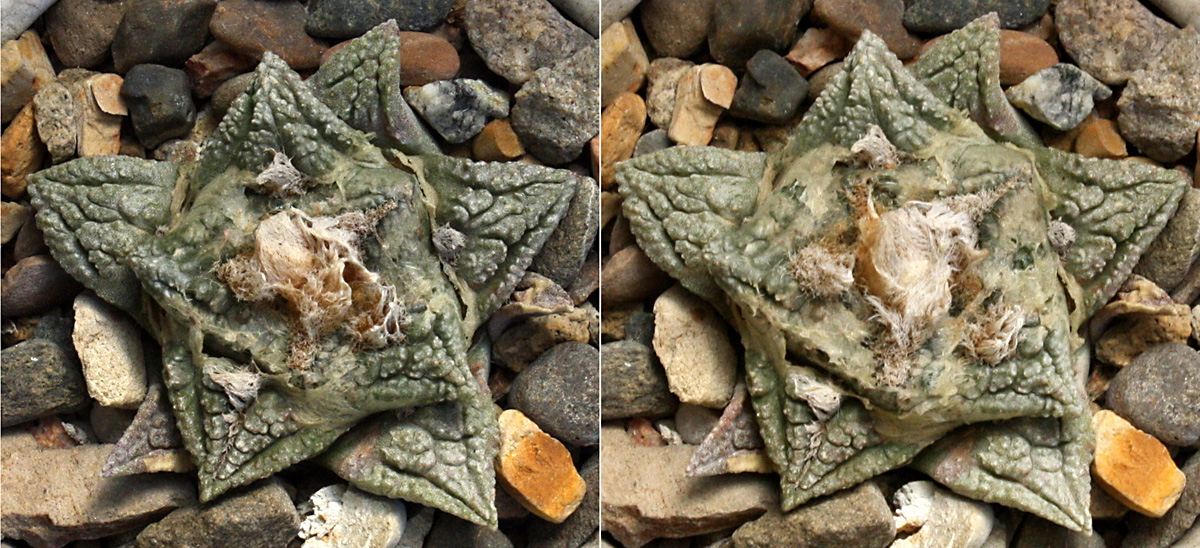
Although it may not be apparent in these "before and after" shots, the Ario has been growing better with the Potassium sulfate and CalMag supplementing the Dyna-Gro 7-7-7. But why flowering every 2 years? I have an idea, and it may surprise you -- too much P in relation to N and K. If I'm right about that, lower P in the new fertilizer regimen will lead to another fissuratus flower this November.
If you just want photos without all the blather, please visit my Flickr gallery.
My location: Los Angeles, CA (Zone 10b)
My location: Los Angeles, CA (Zone 10b)
- Steve Johnson
- Posts: 4530
- Joined: Thu Nov 03, 2011 4:44 am
- Location: Los Angeles, CA (Zone 10b)
A good start on the summer
Definitely a strange first half of the year in SoCal -- as nice as it was to get lots of rain and plenty of snow in the local mountains, winter led to a disappointingly cool spring here at Casa de Jefferson Park. But summer did arrive on time at the end of June (finally!), and here are a few summertime blooms from July 1.
Echinocereus rigidissimus rubispinus (received from CoronaCactus Nursery December 2012) -- double-barreled beauty:
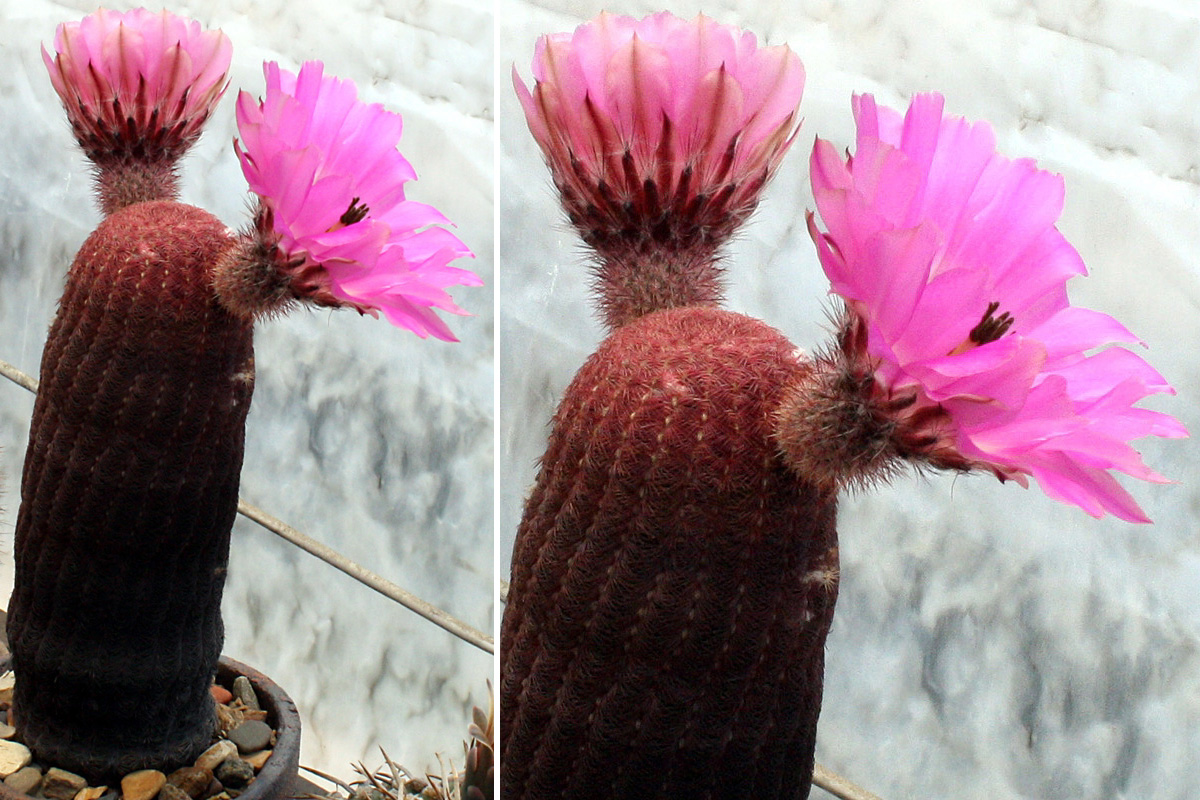
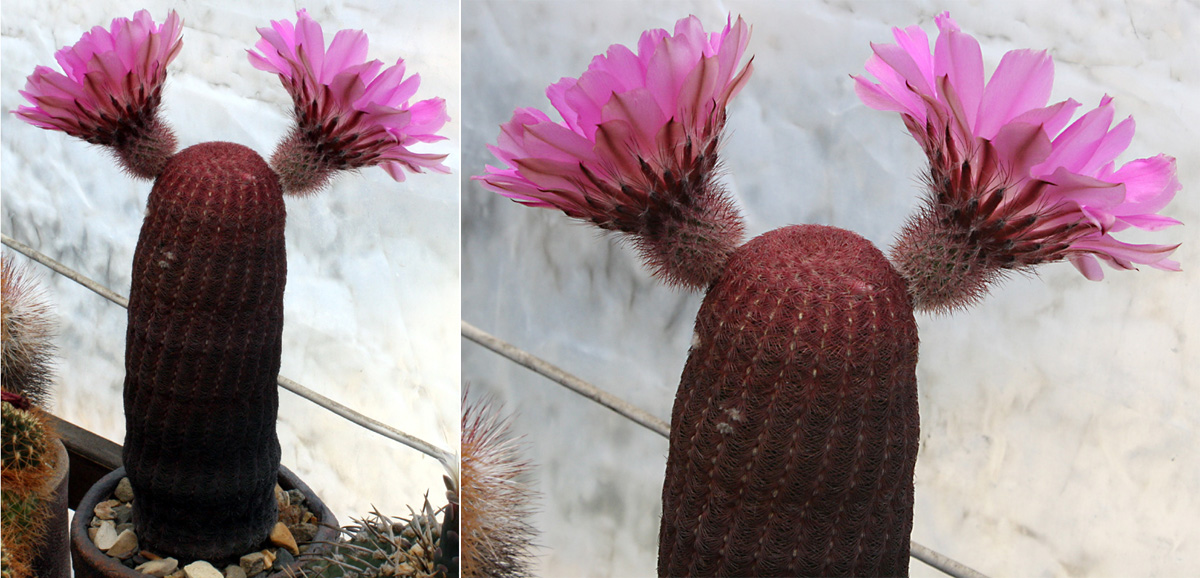
We'll "cut out the middleman" to give you a better side view of the flowers -- bloom #1 on opening day (left), and bloom #2's petal colors fading on its 2nd day:

Smile for the camera!
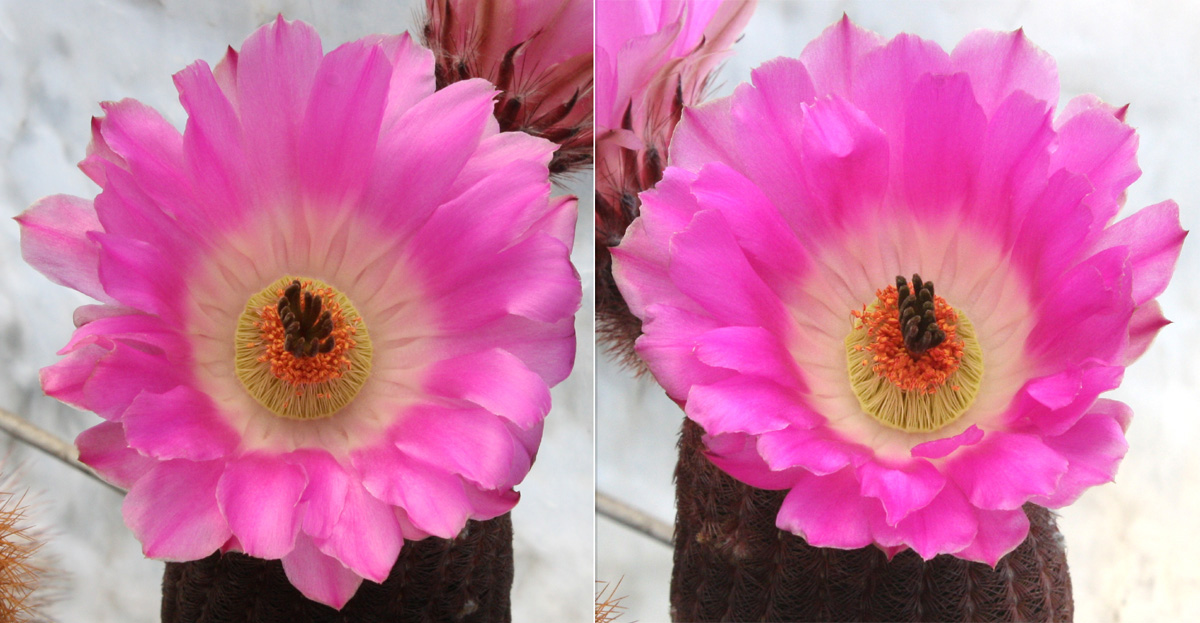
That flower anatomy leaves nothing to the imagination, does it?
Mammillaria theresae (received from Miles' To Go May 2015):


M. theresae is a rather prolific bloomer, but the flowers on mine are more prolific now than they've been in previous years. Is there a reason for that? Yes, and you'll find the answer here:
viewtopic.php?p=401210#p401210
My theresae is by no means the only cactus benefiting from lower P in the fert regimen I've been following this year. However, it's only a small part of the story, and I'll give you the full story after summer is done. Then it'll be time for a 2023 end-of-summer review. (In spite of my best intentions, a 2022 review ain't gonna happen -- apologies to those of you who've been waiting for it.)
Echinocereus rigidissimus rubispinus (received from CoronaCactus Nursery December 2012) -- double-barreled beauty:


We'll "cut out the middleman" to give you a better side view of the flowers -- bloom #1 on opening day (left), and bloom #2's petal colors fading on its 2nd day:

Smile for the camera!

That flower anatomy leaves nothing to the imagination, does it?
Mammillaria theresae (received from Miles' To Go May 2015):


M. theresae is a rather prolific bloomer, but the flowers on mine are more prolific now than they've been in previous years. Is there a reason for that? Yes, and you'll find the answer here:
viewtopic.php?p=401210#p401210
My theresae is by no means the only cactus benefiting from lower P in the fert regimen I've been following this year. However, it's only a small part of the story, and I'll give you the full story after summer is done. Then it'll be time for a 2023 end-of-summer review. (In spite of my best intentions, a 2022 review ain't gonna happen -- apologies to those of you who've been waiting for it.)
If you just want photos without all the blather, please visit my Flickr gallery.
My location: Los Angeles, CA (Zone 10b)
My location: Los Angeles, CA (Zone 10b)
- Steve Johnson
- Posts: 4530
- Joined: Thu Nov 03, 2011 4:44 am
- Location: Los Angeles, CA (Zone 10b)
July 4th Special
The 4th came just a little bit early, so here are the doings from yesterday...

What I didn't realize at the time was that some species of cacti can be remarkably sensitive to NPK imbalance and nutrient deficiencies, the deficiencies being K, Ca, Mg, and S. With the imbalance and deficiencies corrected, the glabrescens is the "difficult" cactus that has shown the most significant improvement in a relatively short period of time. The polaskiis were "difficult" too, but not anymore, although it took about 2 years to get there. A few more examples coming up in the 2023 end-of-summer review.
Next we have Sulcorebutia rauschii:
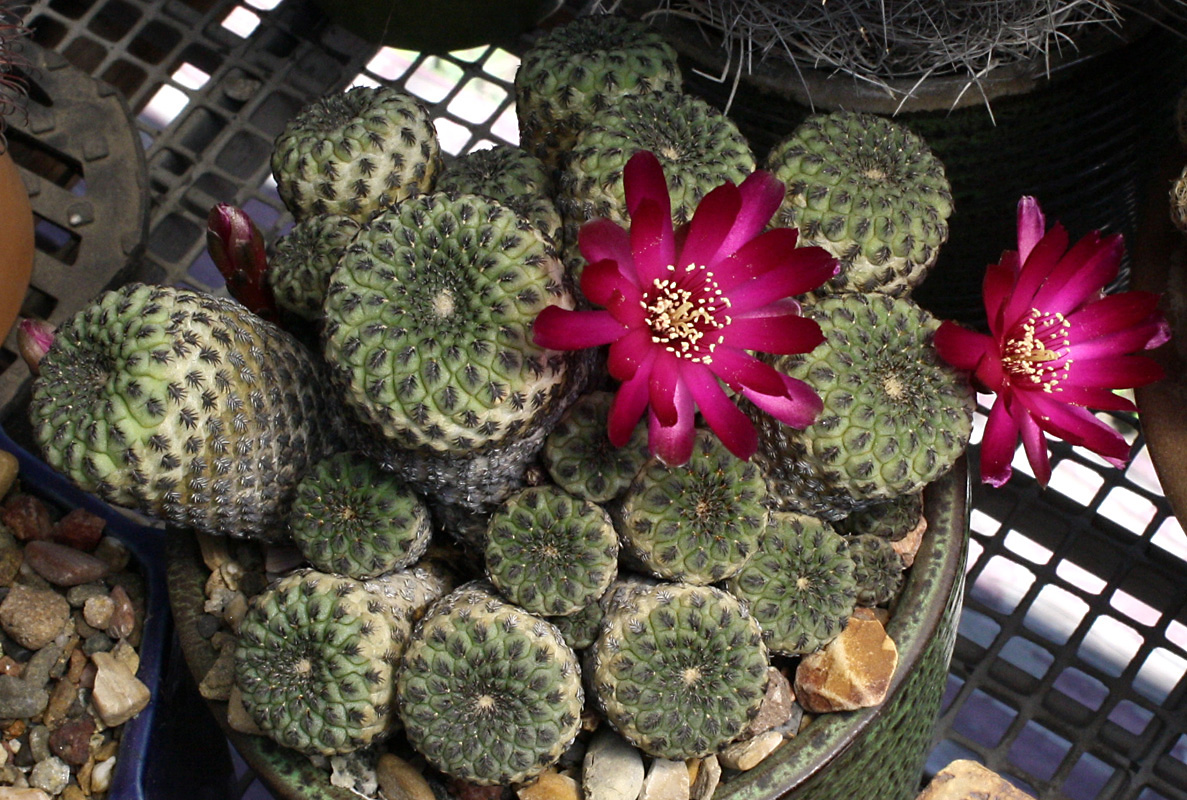
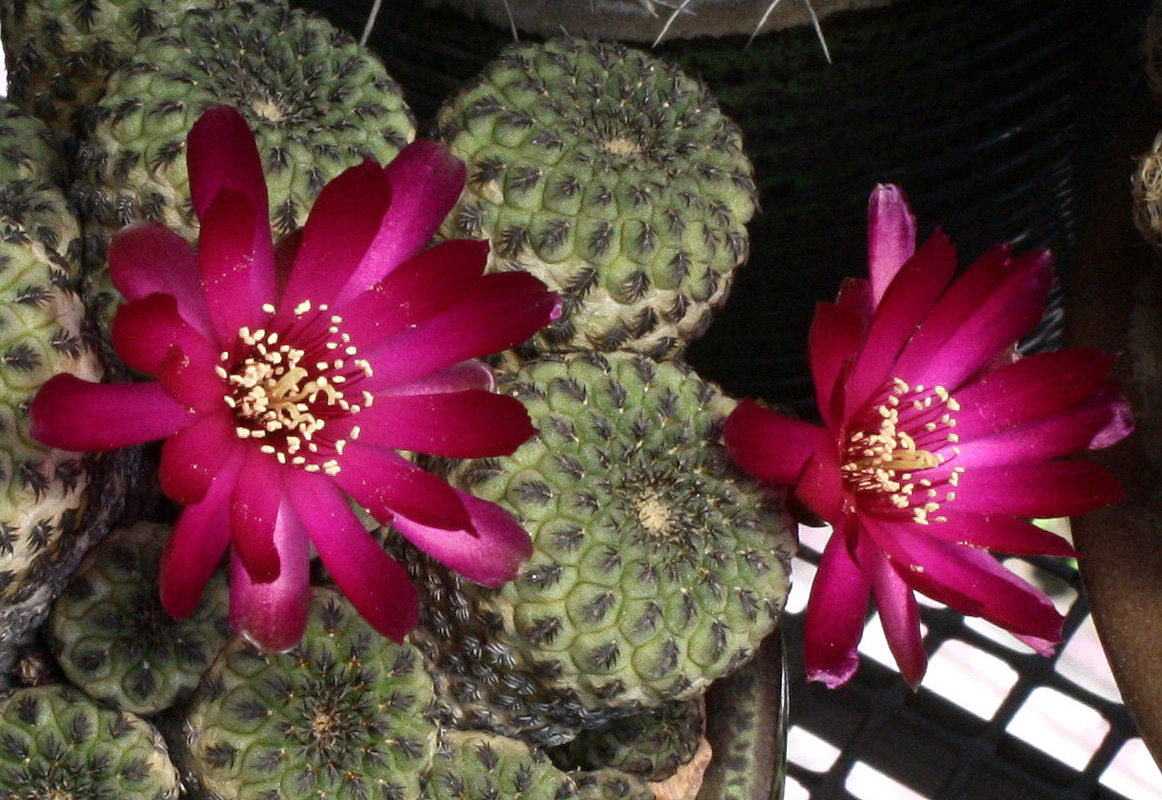
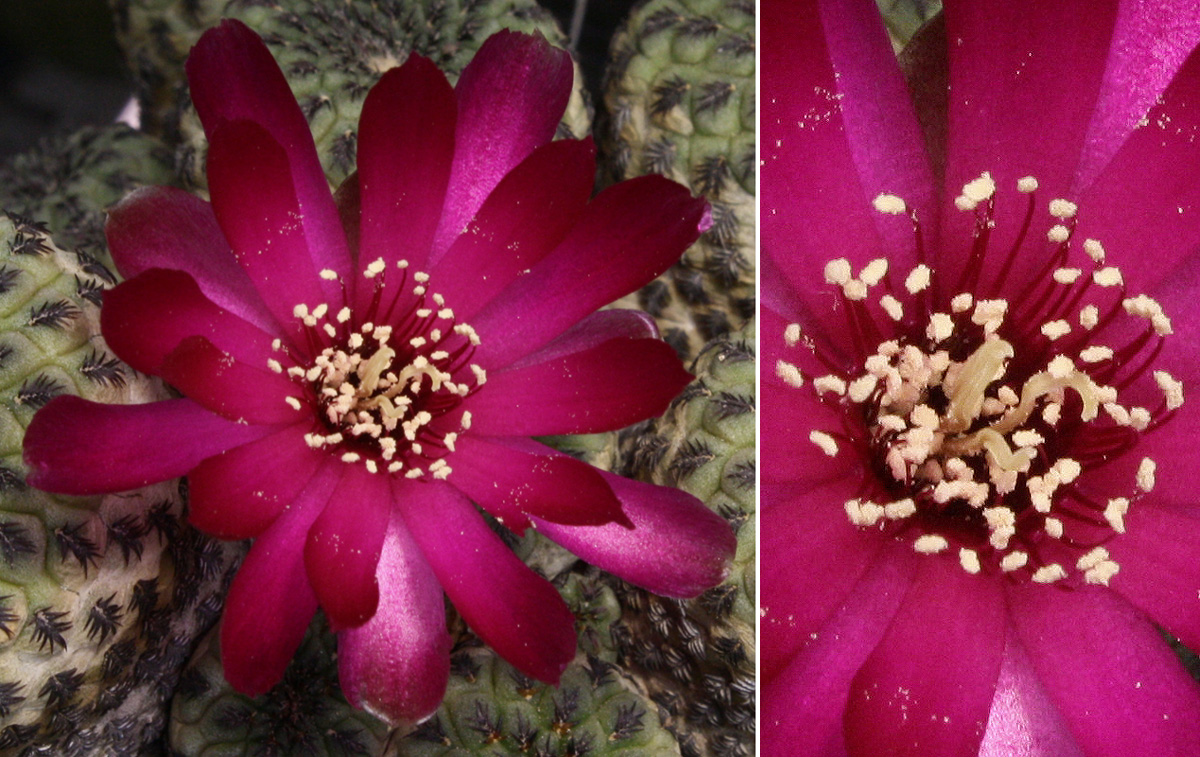
The collection gets its first deep watering of the year with rainwater and nothing more. This year it was April 20 -- a little later than I would like, but not bad. Should've been water and fertilizer every two weeks after that, but the weather had other ideas. First feeding with water was on May 14. Then a touch of winter came back, and I didn't dare water again until things warmed back up in mid-June. The rauschii looks a bit nutrient-starved, although with regular water and fert on the summertime schedule, it'll green up nicely by the end of August. In the meantime, we can see something nice now -- active growth points indicated by off-white "belly button lint" on top plus 2 more buds about to bloom. And believe it or not, what you're seeing here started out in 2011:
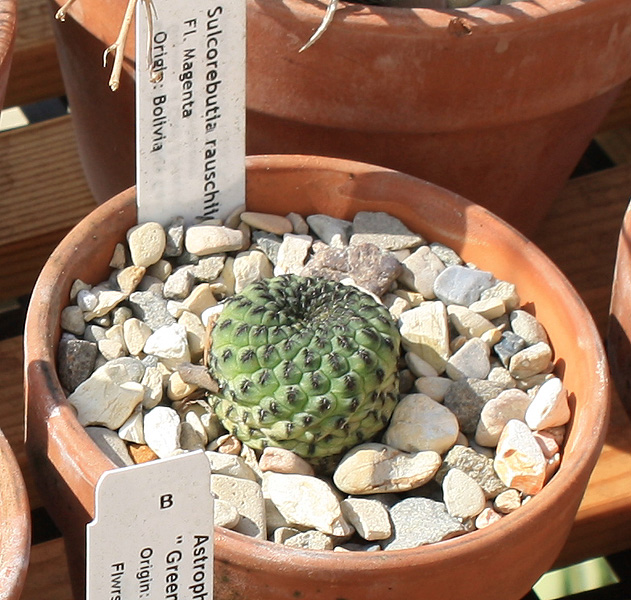
4th of July fireworks tonight, but here's some fireworks we can see in the daytime:

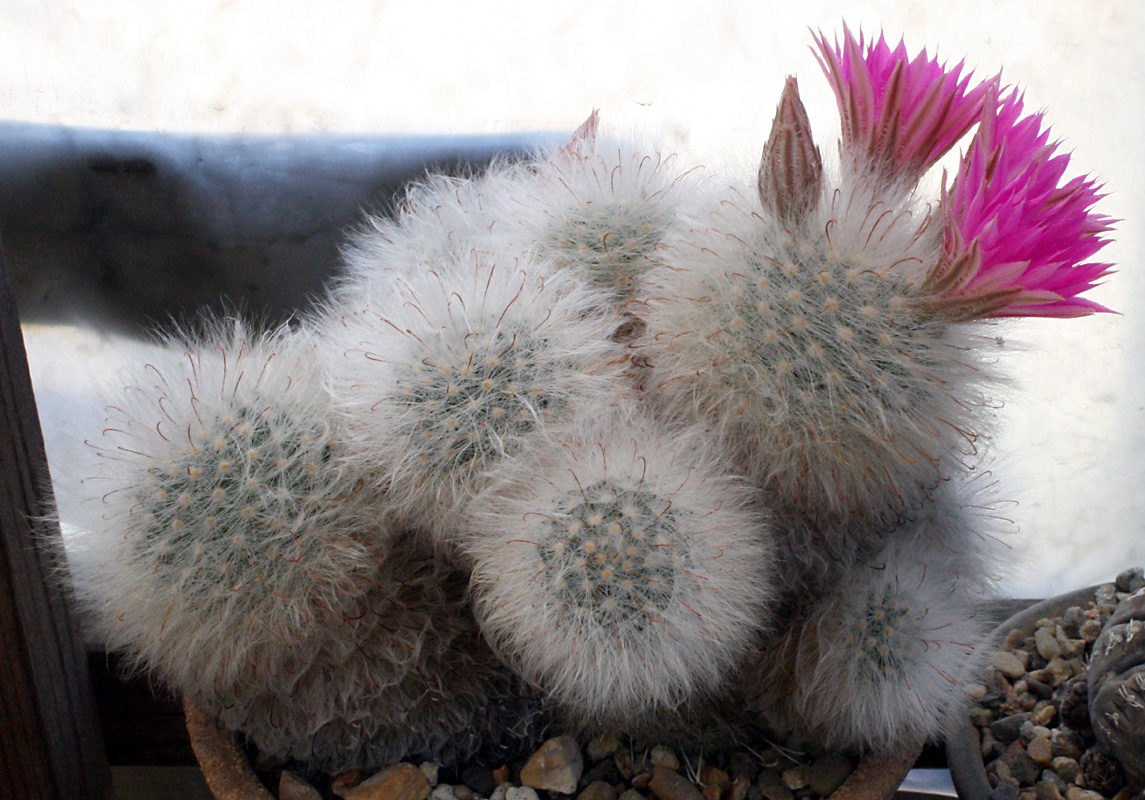



Combine beautiful plant form and drop-dead gorgeous flowers -- IMO Mamm guelzowiana is the best of the genus.

- Back row left to right -- Mammillaria guelzowiana, Gymnocalycium stellatum (or ragonesei?), Turbinicarpus jauernigii, Eriosyce napina glabrescens, and G. stenopleurum.
- In front of the Gymno (yeah, I think it's ragonesei) and T. jauernigii, we have a couple of Turb polaskiis -- one from the California Cactus Center and the other from CoronaCactus Nursery.
- Front row left to right -- Coryphantha hesteri, Copiapoa hypogaea, C. tenuissima, and C. laui.
- I got the Mamm guelzowiana from Miles' To Go in July 2013. After 9 years of too much P in the Dyna-Gro 7-7-7, the plant decided to stop flowering last year. With the reduced P in my new fertilizer regimen, the flowers are back.
- Just like it's been with my Mamm theresae, the Turb polaskiis are blooming more now than they were in previous years. Yep, that's the reduced P.
- I got the E. glabrescens from CoronaCactus in July 2013, and the plant grew not at all with the 7-7-7. But when I supplemented it with Potassium sulfate and TPS Cal-Mag last year, the glabrescens finally started growing. Reduced P in the new fert regimen is giving us this:
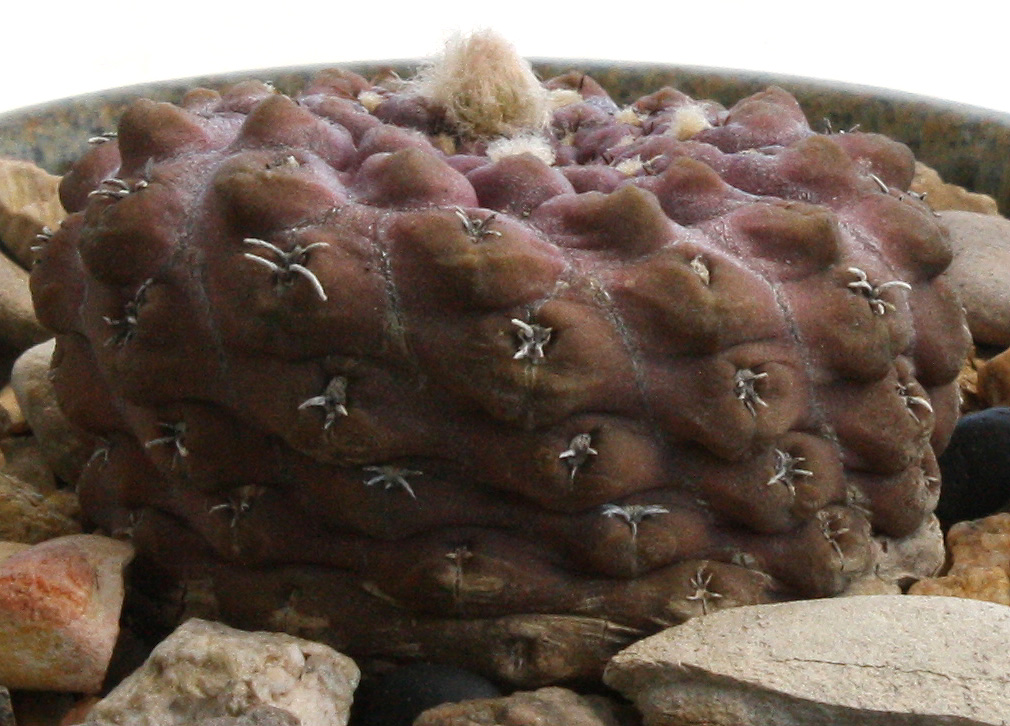
Yes, my friends -- that's a bud! If it goes from bud to bloom, I'll try to get it on camera.
What I didn't realize at the time was that some species of cacti can be remarkably sensitive to NPK imbalance and nutrient deficiencies, the deficiencies being K, Ca, Mg, and S. With the imbalance and deficiencies corrected, the glabrescens is the "difficult" cactus that has shown the most significant improvement in a relatively short period of time. The polaskiis were "difficult" too, but not anymore, although it took about 2 years to get there. A few more examples coming up in the 2023 end-of-summer review.
Next we have Sulcorebutia rauschii:



The collection gets its first deep watering of the year with rainwater and nothing more. This year it was April 20 -- a little later than I would like, but not bad. Should've been water and fertilizer every two weeks after that, but the weather had other ideas. First feeding with water was on May 14. Then a touch of winter came back, and I didn't dare water again until things warmed back up in mid-June. The rauschii looks a bit nutrient-starved, although with regular water and fert on the summertime schedule, it'll green up nicely by the end of August. In the meantime, we can see something nice now -- active growth points indicated by off-white "belly button lint" on top plus 2 more buds about to bloom. And believe it or not, what you're seeing here started out in 2011:

4th of July fireworks tonight, but here's some fireworks we can see in the daytime:





Combine beautiful plant form and drop-dead gorgeous flowers -- IMO Mamm guelzowiana is the best of the genus.
If you just want photos without all the blather, please visit my Flickr gallery.
My location: Los Angeles, CA (Zone 10b)
My location: Los Angeles, CA (Zone 10b)
Re: A small collection: 2015 and beyond
very beautiful flowers and nice collection.
- Steve Johnson
- Posts: 4530
- Joined: Thu Nov 03, 2011 4:44 am
- Location: Los Angeles, CA (Zone 10b)
Re: A small collection: 2015 and beyond
If you just want photos without all the blather, please visit my Flickr gallery.
My location: Los Angeles, CA (Zone 10b)
My location: Los Angeles, CA (Zone 10b)
-
Minnesota
- Posts: 100
- Joined: Mon Aug 22, 2022 1:00 am
- Location: St. Louis Park, MN. Zone 4b, Great Plains/Upper Midwest
- Contact:
Re: A small collection: 2015 and beyond
Bret
- Steve Johnson
- Posts: 4530
- Joined: Thu Nov 03, 2011 4:44 am
- Location: Los Angeles, CA (Zone 10b)
Re: A small collection: 2015 and beyond
Thanks!
If you just want photos without all the blather, please visit my Flickr gallery.
My location: Los Angeles, CA (Zone 10b)
My location: Los Angeles, CA (Zone 10b)
- nachtkrabb
- Posts: 1551
- Joined: Tue May 23, 2006 7:07 pm
- Location: Stuttgart, Germany
Re: A small collection: 2015 and beyond
Hi Steve  ,
,
I do love your plants & your pots (see discussion in this topic). Thanks for sharing.
Nachtkrabb
I do love your plants & your pots (see discussion in this topic). Thanks for sharing.
Nachtkrabb
Love and Revolution!
...and still more cacti.
...and still more cacti.
Re: A small collection: 2015 and beyond
The Mamm.guelzowiana is adorable! 
Re: A small collection: 2015 and beyond
I agree, that guelzowiana is awesome.
- Steve Johnson
- Posts: 4530
- Joined: Thu Nov 03, 2011 4:44 am
- Location: Los Angeles, CA (Zone 10b)
Re: A small collection: 2015 and beyond
Awesome and awesomer -- check out the view from today:

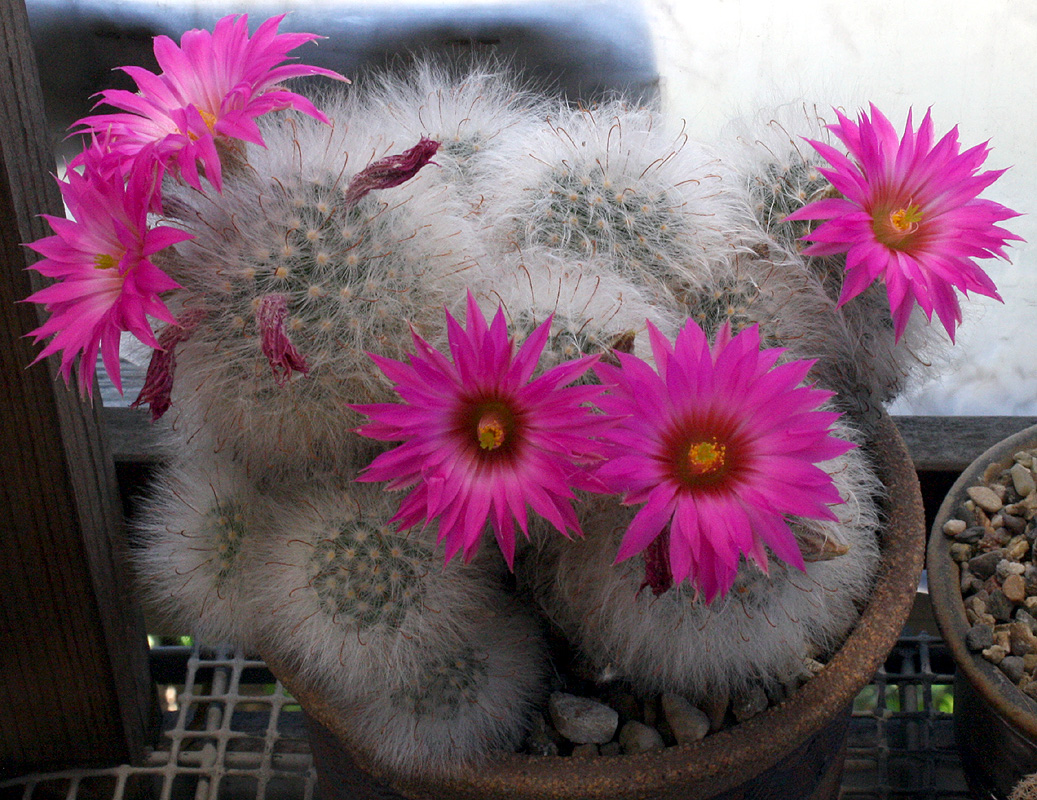
The guelzowiana hasn't been a reliable bloomer -- no flowers in 2017, 2020, and 2022. Could 9 years of too much P in the Dyna-Gro 7-7-7 have something to do with it? Quite possibly. The highest number of flowers I've seen on the plant was 10 back in 2016. Now we have 7 accounted for with 2 buds that'll go into bloom, and since I brought the P down with my new fert regimen starting in spring, the guelzowiana may end up with even more buds and its best flowering year ever. And it's not just about flowering either -- on the matter of high vs. low P, I have a little something for y'all to chew on...
In July of last year I started a thread called "The Cal-Mag of my dreams?" on the Cultivation forum. This was about the TPS CalMag I'm using. And it led to a rather vigorous debate between jerrytheplater and MikeInOz regarding the high P/low P issue. Here are a couple of the posts:
jerrytheplater wrote: ↑Wed Feb 15, 2023 4:12 am Steve
Thanks for the reminder about SDK1's posts. I did read them when they were posted and responded but did not follow up on Mike's book. I will see if I can borrow a copy from the library. I just went back and read the whole "When Cactus Turn Yellow" thread where MikeinOz gives his rationale for his ratio. SDK1 also went into plant tissue analysis. This is making more sense to me.
In the chart Mike gave, converting the tissue analysis to a elemental NPK ratio, you get for leaves: 1-0.26-1.66. For flowers you get: 1-0.17-1.62. In the Cholla stem analysis you get the following N:P ratios: 1:0.067 to 1:0.125. That is some pretty good evidence for lower P in fertilizers since plant tissues don't show high P levels compared to N and K.
MikeinOz said: "too much P can interfere with trace element uptake especially iron and it can reduce flowering. Too much K is very rare and usually not an issue."
So, now to see what "too much P" is. Maybe its in the book Mike supplied. When is iron uptake impaired?
Going by the NPK ratio set with N as a constant of 1, the Dyna-Gro 7-7-7's P at 0.44 was too high, but not high enough to cause serious long-term problems -- yet. Based on my observations so far, I've found that some species are more tolerant of the higher P than others. However, that tolerance lasts only so long, and for growers who dismiss the importance of keeping the P in their ferts down to a more acceptable level, they'll find that their cacti won't grow as well as they did in the past.MikeInOz wrote: ↑Wed Feb 15, 2023 5:22 amJerry, given that Phalaenopsis orchids are probably the most studied ornamental greenhouse crop, there is a lot of literature on their fertilization out there. Google scholar is the place to start reading.jerrytheplater wrote: ↑Tue Feb 14, 2023 4:46 am
I'd like to see some references that show what the effects of over feeding with P causes. Do you happen to know of any? I need to go over those articles I posted up last week. Might be something in there.Too much P can lead to reduced growth, reduced flowering and interference with trace element uptake as well as outright toxicity if the dose is over the top....
If you just want photos without all the blather, please visit my Flickr gallery.
My location: Los Angeles, CA (Zone 10b)
My location: Los Angeles, CA (Zone 10b)
- jerrytheplater
- Posts: 1165
- Joined: Mon Mar 22, 2021 7:38 pm
- Location: Bloomingdale, NJ (USDA Zone 6b)
- Contact:
Re: A small collection: 2015 and beyond
Hey Steve, since you are quoting a lot of what I wrote, I'll post here, but maybe I should back in your thread.
I did see a graph of corn production in one of Mike's references (I think) which showed that increased P over what is termed "sufficient" in the literature, did not impact corn yields in any way up or down. It only led to wasted application of extra P and maybe more runoff of P. That is for the grass plant Corn, Zea mays.
I did see a mention of High P giving reduced blossoms in African Violets. Turns out it was lower light levels that had a much greater effect on blossoms than P levels. Increasing light levels increased bloom production. I did make up a modified fertilizer for my violets that converts Dyna-Gro Bloom 3-5.2-5.0 to 13.1-5.2-22.2 (1.0-0.4-1.7) in elemental terms. NH4:NO3 is 3.1:10.0 in the modified mix. Bloom is 0.7:2.3.
This conversion reduced the P levels from equal to K to about 1/4 K. Now it will be up to me to give a subjective idea of the results. But, I just did a major repotting of all of my violets to reduce long necks which involved decapitating the plants and re-rooting the top part. I took leaf cuttings of all as insurance. Now I have too many violets!
I did see a graph of corn production in one of Mike's references (I think) which showed that increased P over what is termed "sufficient" in the literature, did not impact corn yields in any way up or down. It only led to wasted application of extra P and maybe more runoff of P. That is for the grass plant Corn, Zea mays.
I did see a mention of High P giving reduced blossoms in African Violets. Turns out it was lower light levels that had a much greater effect on blossoms than P levels. Increasing light levels increased bloom production. I did make up a modified fertilizer for my violets that converts Dyna-Gro Bloom 3-5.2-5.0 to 13.1-5.2-22.2 (1.0-0.4-1.7) in elemental terms. NH4:NO3 is 3.1:10.0 in the modified mix. Bloom is 0.7:2.3.
This conversion reduced the P levels from equal to K to about 1/4 K. Now it will be up to me to give a subjective idea of the results. But, I just did a major repotting of all of my violets to reduce long necks which involved decapitating the plants and re-rooting the top part. I took leaf cuttings of all as insurance. Now I have too many violets!
Jerry Smith
Bloomingdale, NJ
45 inches (114 cm) rain equivalent per year, approx. evenly spread per month
2012 USDA Hardiness Zone 6b: -5F to OF (-20C to -18C) min.
Bloomingdale, NJ
45 inches (114 cm) rain equivalent per year, approx. evenly spread per month
2012 USDA Hardiness Zone 6b: -5F to OF (-20C to -18C) min.
- Steve Johnson
- Posts: 4530
- Joined: Thu Nov 03, 2011 4:44 am
- Location: Los Angeles, CA (Zone 10b)
Re: A small collection: 2015 and beyond
Before Mike joined the forum's fertilizer discussions in August 2020, I made a bad assumption about what the "ideal" NPK balance should be for cacti and succulents. And of course I was repeating misinformation I got from people who didn't know what they were talking about. Once I got some really good learning from him, I was surprised to find out that cacti and succulents share commonalities with nonxeric plants in terms of the actual balances that produce optimal growth. From there I came up with a basic "rule of thumb" -- P lower than N, K higher than both. Fine as far as it goes, but this doesn't tell us much without plugging N, P, and K numbers into the rule. Jerry, you and I already know this, so the following is for the benefit of members who may be new to the investigation of ferts...jerrytheplater wrote: ↑Tue Jul 18, 2023 2:18 pm Hey Steve, since you are quoting a lot of what I wrote, I'll post here, but maybe I should back in your thread.
I did see a graph of corn production in one of Mike's references (I think) which showed that increased P over what is termed "sufficient" in the literature, did not impact corn yields in any way up or down. It only led to wasted application of extra P and maybe more runoff of P. That is for the grass plant Corn, Zea mays.
I did see a mention of High P giving reduced blossoms in African Violets. Turns out it was lower light levels that had a much greater effect on blossoms than P levels. Increasing light levels increased bloom production.
The N, P, and K numbers we're looking for are ratio, dilution rate, and the amount of these nutrients going into our plants per feeding. If we have the ratio and dilution rates right (see viewtopic.php?t=47603), it's simply a matter of knowing how often we should fertilize when they're watered. In 2012 I chose to move almost all of my cacti from a soil-based mix to a soilless pumice and granite gravel mix. Wide-open aeration in the mix produces the kind of robust, healthy root growth I simply wouldn't get in a soil-based mix. Only downside is that it's an essentially hydroponic approach, so I have to fertilizes every time I water my cacti in the growing season. However, better root growth = better stem growth, and in fact I enjoy the "ritual" of whipping up my watering solution whenever it's time to water. Obviously this isn't for everyone, and growers who use a soil-based mix won't need to fertilize as often.
Regardless of whether growers are using soilless or soil-based mixes, I'll go back to an important point Mike made:
He wasn't specific about the kind of reduced growth we're talking about, although I have a feeling that too much P in relation to N and K inhibits uptake of both nutrients, thus reducing root and stem growth. As I said in my previous post, this isn't just about flowering. Proof in the pudding:
That's a nice problem to have!jerrytheplater wrote: ↑Tue Jul 18, 2023 2:18 pmI did make up a modified fertilizer for my violets that converts Dyna-Gro Bloom 3-5.2-5.0 to 13.1-5.2-22.2 (1.0-0.4-1.7) in elemental terms. NH4:NO3 is 3.1:10.0 in the modified mix. Bloom is 0.7:2.3.
This conversion reduced the P levels from equal to K to about 1/4 K. Now it will be up to me to give a subjective idea of the results. But, I just did a major repotting of all of my violets to reduce long necks which involved decapitating the plants and re-rooting the top part. I took leaf cuttings of all as insurance. Now I have too many violets!
If you just want photos without all the blather, please visit my Flickr gallery.
My location: Los Angeles, CA (Zone 10b)
My location: Los Angeles, CA (Zone 10b)
Re: July 4th Special
Steve Johnson wrote: ↑Tue Jul 04, 2023 10:09 pm The 4th came just a little bit early, so here are the doings from yesterday...

- Back row left to right -- Mammillaria guelzowiana, Gymnocalycium stellatum (or ragonesei?), Turbinicarpus jauernigii, Eriosyce napina glabrescens, and G. stenopleurum.
- In front of the Gymno (yeah, I think it's ragonesei) and T. jauernigii, we have a couple of Turb polaskiis -- one from the California Cactus Center and the other from CoronaCactus Nursery.
A few observations worthy of note:
- Front row left to right -- Coryphantha hesteri, Copiapoa hypogaea, C. tenuissima, and C. laui.
- I got the Mamm guelzowiana from Miles' To Go in July 2013. After 9 years of too much P in the Dyna-Gro 7-7-7, the plant decided to stop flowering last year. With the reduced P in my new fertilizer regimen, the flowers are back.
- Just like it's been with my Mamm theresae, the Turb polaskiis are blooming more now than they were in previous years. Yep, that's the reduced P.
- I got the E. glabrescens from CoronaCactus in July 2013, and the plant grew not at all with the 7-7-7. But when I supplemented it with Potassium sulfate and TPS Cal-Mag last year, the glabrescens finally started growing. Reduced P in the new fert regimen is giving us this:
Yes, my friends -- that's a bud! If it goes from bud to bloom, I'll try to get it on camera.
What I didn't realize at the time was that some species of cacti can be remarkably sensitive to NPK imbalance and nutrient deficiencies, the deficiencies being K, Ca, Mg, and S. With the imbalance and deficiencies corrected, the glabrescens is the "difficult" cactus that has shown the most significant improvement in a relatively short period of time. The polaskiis were "difficult" too, but not anymore, although it took about 2 years to get there. A few more examples coming up in the 2023 end-of-summer review.
Next we have Sulcorebutia rauschii:
The collection gets its first deep watering of the year with rainwater and nothing more. This year it was April 20 -- a little later than I would like, but not bad. Should've been water and fertilizer every two weeks after that, but the weather had other ideas. First feeding with water was on May 14. Then a touch of winter came back, and I didn't dare water again until things warmed back up in mid-June. The rauschii looks a bit nutrient-starved, although with regular water and fert on the summertime schedule, it'll green up nicely by the end of August. In the meantime, we can see something nice now -- active growth points indicated by off-white "belly button lint" on top plus 2 more buds about to bloom. And believe it or not, what you're seeing here started out in 2011:
4th of July fireworks tonight, but here's some fireworks we can see in the daytime:
Combine beautiful plant form and drop-dead gorgeous flowers -- IMO Mamm guelzowiana is the best of the genus.
Steve!!!! See your patience paid off!!!! Beautiful!!!!
My name is Joe I Live in Hickory NC USA four equal perfect seasons.










